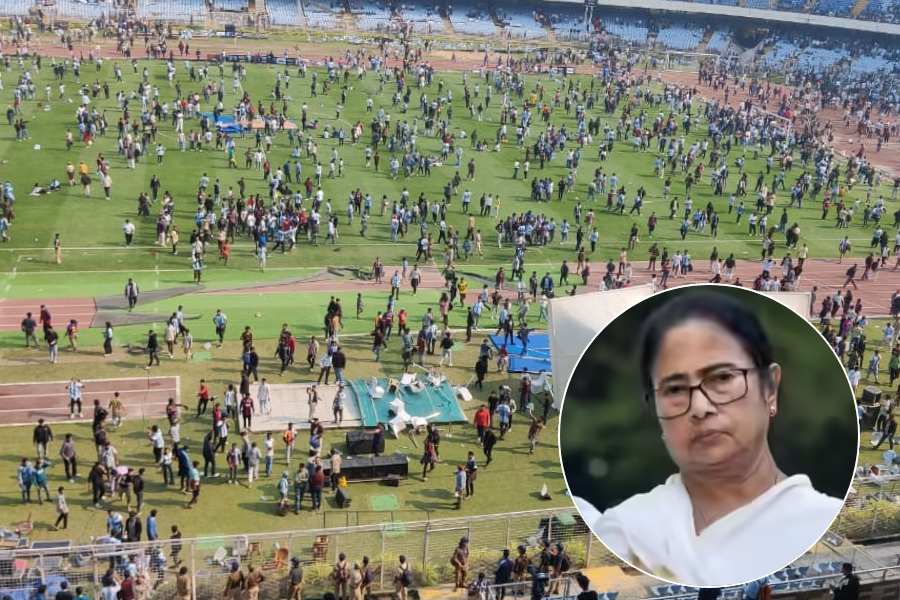|
|
Recently, while shooting a TV series on various facets of Calcutta’s heritage, we found ourselves working in one of the great old theatres of North Calcutta, now sadly moribund and decrepit. While some of us ‘culture’ enthusiasts were lamenting its sorry state and discussing how it could be restored to its former glory, I overheard a light technician wondering loudly why the theatre could not be pulled down and a housing estate come up in its place! One man’s cultural heritage can be another’s hope for reasonable housing and yet another’s for a killing on the real estate market. Which raises a fundamental question: What really does heritage mean?
For a start, ask a lay person what heritage means to him or her and the response will probably have two components. One will have to do with the ‘hard’ heritage aspect — buildings or institutions of one kind or another. The other will have to do with the ‘soft’ heritage aspect — literature, music, the arts, cinema and so on. In the ordinary consciousness of a person, these two components overlap or merge to conjure up a memory of some kind of a glorious past. There is also a nagging feeling that somehow this past needs to be preserved. But preserved for what exactly? That, alas, is not that simple to define!
Is heritage, then, mainly in the eye of the beholder? Does our educational and cultural conditioning determine what we regard as heritage? Does it influence what we think should be preserved as heritage? And who are the ‘we’, anyway? There is no universal or monolithic ‘we’ in any society. So, does only the dominant discourse — the discourse of the cultural, political and financially powerful class — decide what heritage is?
In the context of cinema in Calcutta, it is important to arrive at some understanding of or agreement on what the concept of this heritage is. Ask the average middle- class Bengali about this. The chances are that you will get three names thrown right back at you. No prizes for guessing which three! Satyajit Ray, Mrinal Sen and Ritwick Ghatak, thus dating the heritage of Bengali cinema to no more than half a century ago.
But, let’s get a little more rigorous. Google the phrase, ‘The heritage of Bengali cinema’, and you’ll get some scholarly material, mostly from foreign universities. You’ll get a smattering of historical data. You’ll also get a little Ghatak and a little Sen. And you’ll be inundated by wave upon wave of Ray, the refrain being “Ray is the one filmmaker who set Bengali cinema on the international stage”, if you will pardon the mixed metaphor.
It goes without saying that my intention is not to question or belittle the truth of that statement, but to suggest that heritage is quite often symbolic. Achievement, recognition or applause that arise from a thing often become more important than the thing itself. Whose heritage is it anyway? That’s the first — and central — question. What about the bulk of the Bengali cinema-going audience that has never heard of this hallowed triumvirate? Should the heritage of the majority be any less valuable than that of the minority?
The second important question: How do you date heritage? Tracing the architectural, literary, musical and theatrical heritage of Calcutta takes us back 200 years or more. Cinematic history, on the other hand, dates back to just over a century. The details of that history are well known. We know that the development of cinema in Calcutta took place more or less simultaneously with its development elsewhere in terms of both filmmaking and exhibition. A brief chronology would look like this. Travelling shows in tents and fairgrounds; Hiralal Sen’s films; the first permanent theatre (Elphinstone) in 1907; the first full-length feature (Bilwamangal) in 1919; the first talkie to be shown in India (Universal’s Melody of Love, at Elphinstone, in 1929); the first Bengali talkie, probably in 1931 (was it Amar Choudhury’s Jamai Shasthhi or Premankur Aatarthi’s Dena Paona?); the founding of New Theatres in 1931; the first use of background music by the director, Debaki Bose, and the sound recordist, Mukul Bose, in Chandidas (1932); the first use of playback-singing by the director, Nitin Bose, in Bhagya Chakra (1935); Pramathesh Barua’s Devdas (1935), probably the first superhit based on a literary work; probably the first film to be banned for political reasons, Biyallish (1942); the emergence of stars with Pramathesh Barua and Kanan Debi in the 1930s and 1940s; the emergence of Arun Kumar in Drishtidaan (1948); the reincarnation of Arun Kumar as Uttam Kumar and the superhits, Basu Paribar (1951) and Agni Pariksha (1953), and with that, the beginning of what has come to be called the ‘golden age’ of Bengali cinema; the advent of consciously political (should we call it neo-realist?) cinema with Nimai Ghosh’s Chhinnamul in 1950; and Pather Panchali (1955).
What are the high points in this chronology? I would identify four signposts. First, the fairly early relationship that cinema developed with literature, through texts like Durgesh Nandini and Krishnakanter Will; second, the establishment of New Theatres in 1931; third, the emergence of Uttam Kumar in 1950; and fourth, Pather Panchali (1955). Literature, classical and contemporary, gave Bengali cinema a rich source of sustenance for many years. One might say that Bengali cinema only faltered, in business and in artistic terms, when it moved away from literature to the formulaic cinema of Bombay from the 1980s.
New Theatres, for the first time, created a comprehensive system of filmmaking by bringing together writers, directors, technicians, actors and equipment under one roof. The New Theatres ethos was not only admired for its commercial viability and machine-like coordination, but was also celebrated as a way of life of the Bengali bhadralok. This spirit of bhadrata is what New Theatres became a symbol of. And this is the spirit that pervaded Bengali cinema, for good or for bad, certainly for the next half a century.
Eminent actors like Pramathesh Barua, Kanan Debi, the great Shishir Bhaduri himself, Pahari Sanyal and a host of others graced the Bengali screen from the early days. But the emergence of Uttam Kumar was something else altogether. He was truly the first superstar of Bengali cinema, perhaps because he symbolized the bhadrata that characterized the Bengali middle class. He was the helpful boy next door, the dutiful son, the responsible husband, the respectful son- in-law, the fearless fighter against all evils... You name it, and Uttam Kumar was it. For three decades, Uttam Kumar, the ultimate icon, ruled the screen with an astonishing 188 films, consistently averaging almost 6 films a year.
Then came Satyajit Ray’s Pather Panchali in 1955. Volumes have been written about this film and its impact on cinema in India and, indeed, the world. In the context of cinema in Calcutta, four points seem important. Pather Panchali heralded the beginning of ‘personal’ cinema — a filmmaker having the conviction and the will to make a film on his own, rather than the audience’s, terms. And this had to do as much with form as with content.
Personal cinema drew on literature, but stood that tradition on its head. The text became merely the raw material from which the film-maker fashioned his own personalized narrative. You see this as much in Pather Panchali as you do in Ghatak’s Ajaantrik and Meghe Dhaka Tara and, somewhat later, in Sen’s Bhuvan Shome. It also revolutionized the star system with the director, rather than the actor, becoming the new star. The personal narrative became both socially and culturally political. It established Bengali cinema firmly in the international arena. Whatever the label — art cinema, independent cinema, personal cinema — a parallel trend of film-making began that was to co-exist with mainstream cinema for at least the next 25 years.
No trend, of course, is as simple or as homogeneous as it appears to be on the surface. The bhadra ethos of Bengali cinema came under attack. Hard questions began to be asked in cinema — about social and political values, the star system, the presence of songs, the portrayal of the underclass and even of nature. From being merely a romantic background for cavorting lead players, nature became part of the dramatis personae. Particularly in the work of Ghatak, nature became hard, unforgiving, indifferent to the travails of human beings. In refusing to play to the gallery, the parallel cinema often became contemptuous of the audience. State funding empowered minority cinema, but it was not always responsibly used. While freedom from the system encouraged experimentation, it often led to amateurish efforts.
An ‘Us versus Them’ mentality appeared both within the film community and among the audience. If you were a film-society type, you turned your nose up at the Uttam-Suchitra matinee-show lot. And if you were an Uttam-Suchitra devotee, you took pride in proclaiming that you had no idea what the antels [intellectuals] were doing. Even within the parallel fraternity, it was often the case that if you admired Ray, you had to pull down Sen and vice versa. But that is another complicated story.
This leads to another question about the whole issue of heritage. Heritage is not value-neutral; what we regard as heritage depends on who we are. Is, therefore, a notion of legacy attached to the idea of heritage? Do institutions and individuals work consciously to build up a heritage for future generations? Or do social and cultural dynamics operate autonomously to determine what a community’s heritage is to be? This is not a question for the faint-hearted, and I certainly lay no special claim to being able to answer it. But I am raising this question because much has been made of the fact that Bengali cinema has cut loose from its moorings, that the legacies of its eminent filmmakers are being forgotten or ignored. But then, some very real and radical changes have occurred, starting from the 1980s.
Cinema is no longer the pre-eminent audiovisual medium; television is. It is TV, the internet and the myriad globalized ideas and images they bring to our homes that are shaping the aesthetics of the current generation of viewers. Cinema is no longer the forum for political discourse. For one thing, TV has overtaken it; for another, in the globalized, neo-liberal world, political discourse itself has taken something of a back seat. Bengali cinema’s bonds with literature have loosened. The bhadra ethos has receded from the Bengali sensibility, and with it, from Bengali cinema. This is being replaced by a doubtful kind of cosmopolitanism.
Commercial viability is now recognized as the absolute mantra. No matter what kind of film you make, you must, as they say, ‘put bums on seats’. There are no bail-outs from government funding agencies any more. For better or for worse, a new trend has emerged that might become the heritage of tomorrow — a middle-of-the-road cinema that both in form and content relies heavily on style and look. Ironically, the parallels may be converging. Institution-building is back, with more and more professionally-run production houses.
So, what will tomorrow’s heritage look like? Much will perhaps remain the same. But I believe there will be one essential change from the past. In the times to come, cinema in Calcutta will no longer be synonymous with Bengali cinema. The space for expression will expand and grow more complex. And it will become more democratic — not necessarily on its own volition, but because that is the nature of the emerging multimedia universe.
The bhadralok will, finally, have to open his doors to the others.











